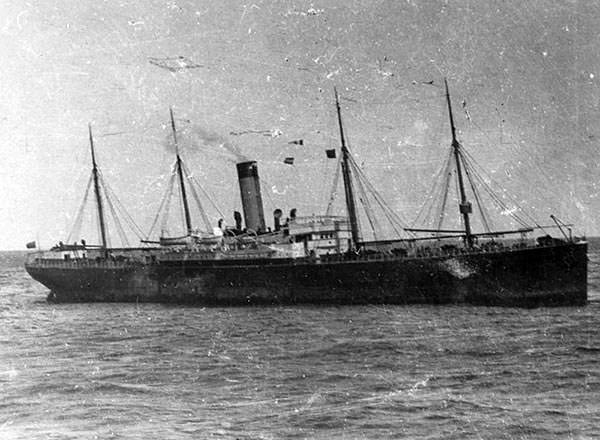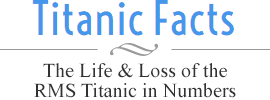Introduction
On the night Titanic sank, the nearest ship to her was the SS Californian, a steamship of the British Leyland Line. However, despite her close proximity, and the distress signals Titanic raised, the Californian took no action – a mystery that resulted in a number of conspiracy theories. Inquiries at the time concluded that many lives could have been saved had Californian responded, and that Captain Stanley Lord’s inaction was reprehensible. Nonetheless, formal charges were never brought against Captain Lord or the crew. Read the fascinating story of Titanic and Californian…

Above: SS Californian photographed the morning after Titanic sank.
55 – the number of crew aboard the Californian.
1911 – the year Captain Stanley Lord became master of the ship.
05 April 1912 – the date the Californian set sail from her home port of Liverpool, headed for Boston, USA.
14 April 2012 – the date that icebergs were encountered, 3 large bergs in total.
7.20pm – the approximate time at which a warning message was sent to the Antillian, another ship of the Leyland Line (this message was heard by the radio operator on Titanic).
42.3° N, 49.9° W – the coordinates at which Californian encountered the ice.
3 hours – the approximate duration after spotting the icebergs that the Californian stopped for the night, after more ice was observed (around 10.15pm).
10.30pm – the time at which Captain Stanley Lord, retiring to his cabin, spotted a light at a distance, and noted it to Third Officer Charles Groves, who was just coming on watch.
10.50pm – the time by which the Captain returned to the bridge (it has been speculated that he was unable to settle, perhaps worried about the light or the ice).
Did You Know?
Upon returning to the bridge, Captain Lord debated the source of the light with Cyril Evans, the ship’s radio operator. Evans thought the light to be Titanic, the only ship known to be in that area, whilst Captain Lord thought the ship to be “closer to us in size”. Nonetheless, he instructed Evans to send a telegram to Titanic to let them know the Californian was stopped among ice.
5 miles – the distance at which Captain Lord thought the other vessel to be, having observed the green starboard light (at around 11.30pm). Second Officer Herbert Stone, taking over the watch at midnight, estimated the same distance. Attempts to make contact via Morse lamp were met without response.
10 miles – the distance at which Ernest Gill, a fireman whose shift had finished around midnight, believed he had seen a large steamer passing. He later recounted how he had “watched her for a full minute. She was going at full speed.”
12.30am – the time at which Gill saw a white rocket in the sky, around 10 miles to the starboard side, initially believing it to be a shooting star.
7 minutes – the approximate duration after which Gill ‘distinctly’ spotted a second rocket in the same area of sky. However, he recalled, “it was not my business to notify the bridge or the look-outs”, and he retired to bed.
Did You Know?
As he ended his shift and retired to bed, radio operator Cyril Evans forgot to set up the automated warning system that would have alerted him to any distress calls they might have received.
12.45am – the time at which Second Officer Stone spotted a flash of light, but believed it to be a shooting star (he had already seen a few real shooting stars earlier that evening).
3 – the number of flashing lights that Stone observed over the following 30 minutes.
1.45am – the time at which Stone contacted the Captain, via the speaking tube to his cabin, and told him about the lights he had seen. Unable to confirm whether they were company signals that he had witnessed, Stone was instructed to retry making contact via Morse light. Still no response came back, whilst Captain Lord remained in his quarters.
15 minutes – the approximate duration after which the unidentified ship appeared to move away, and the Captain was informed.
4.30am – the time at which Captain Lord was woken by Chief Officer George Stewart and returned to the bridge, ahead of resuming their voyage to America.
5.15am – the time at which the Californian’s engines were put on standby, and around the time at which Chief Officer George Stewart spotted a vessel with a yellow funnel (and assumed it to be the vessel whose light they had been seeing). Radio operator Evans was duly woken and sent out a ‘CQ’ (all stations answer). A response came back from the Frankfurt, advising them that the Titanic had sunk.
19 miles – the distance at which Captain Lord believed the disaster scene to be, ordering the Californian to head there at full speed.
8.30am – the time at which the Californian arrived at the scene, coming across the rescue ship Carpathia.
Did You Know?
Upon arriving at the scene, the Californian offered to take some of the survivors aboard. But the Captain of the Carpathia, Captain Rostron, refused, and instead set off for New York immediately. The Californian remained in the area and searched for any further survivors, but none were found.
09 November 1915 – the date the SS Californian was herself sunk, struck by a torpedo from the German submarine U-35 during the hostilities of the First World War.
1992 – the year in which the Marine Accident Investigation Branch, a UK Government body, published the findings from a review of the case. They concluded that, had the Californian reacted to Titanic’s distress signals, they would have been unlikely to achieve anything more than the Carpathia – “that is the rescue of those who escaped”. Nonetheless, the review condemned the inaction.
More To Explore
If you have found these facts about the SS Californian interesting, why not read about the sinking of Titanic, about the recovery of the bodies, or about those passengers and crew who were lucky to survive.
